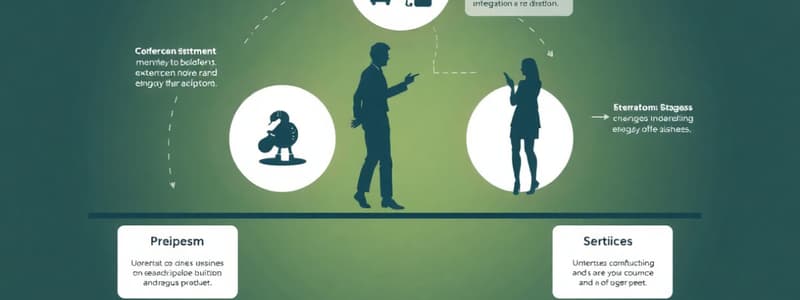Podcast
Questions and Answers
Which of the following BEST describes the 'establishment stage' of the business life cycle?
Which of the following BEST describes the 'establishment stage' of the business life cycle?
- A phase characterized by complacency and a need for restructuring.
- When a business is operating at a steady level without growth.
- When the business first enters the market and focuses on planning. (correct)
- A period of declining sales and profits.
During the 'steady state' phase, businesses typically increase expenditure on research and development to maintain their competitive edge.
During the 'steady state' phase, businesses typically increase expenditure on research and development to maintain their competitive edge.
False (B)
What is the primary difference between the maturity stage and the steady state stage in the business life cycle?
What is the primary difference between the maturity stage and the steady state stage in the business life cycle?
Research and development expenditure.
When a business expands at different but related levels in the production and marketing of a product, it is known as ______ integration.
When a business expands at different but related levels in the production and marketing of a product, it is known as ______ integration.
Match the following types of integration with their correct descriptions:
Match the following types of integration with their correct descriptions:
Which of the following is an example of 'backward vertical integration'?
Which of the following is an example of 'backward vertical integration'?
Horizontal integration occurs when a business merges with a company in a completely unrelated industry.
Horizontal integration occurs when a business merges with a company in a completely unrelated industry.
What is the term for growth that occurs when a business merges with a business in a completely unrelated industry?
What is the term for growth that occurs when a business merges with a business in a completely unrelated industry?
When one business takes control of another by purchasing a controlling interest, it is known as a(n) ______.
When one business takes control of another by purchasing a controlling interest, it is known as a(n) ______.
Match the following terms with their respective descriptions:
Match the following terms with their respective descriptions:
Which stage of the business life cycle often requires a more formal and professional approach to planning?
Which stage of the business life cycle often requires a more formal and professional approach to planning?
A business in the decline stage can easily reverse its situation by increasing its borrowing from financial institutions.
A business in the decline stage can easily reverse its situation by increasing its borrowing from financial institutions.
What is the term for the closure of a business?
What is the term for the closure of a business?
The process of converting the assets of a business into cash is called ______.
The process of converting the assets of a business into cash is called ______.
Match each post-maturity stage with its description:
Match each post-maturity stage with its description:
What is the most common cause of involuntary cessation?
What is the most common cause of involuntary cessation?
Voluntary administration occurs when a court orders the closure of a business due to debt.
Voluntary administration occurs when a court orders the closure of a business due to debt.
What is 'undercapitalization', and why is it a significant factor contributing to business decline?
What is 'undercapitalization', and why is it a significant factor contributing to business decline?
[Blank] is a declaration that a business or person is unable to pay his or her debts.
[Blank] is a declaration that a business or person is unable to pay his or her debts.
Match the following terms with their descriptions of cessation:
Match the following terms with their descriptions of cessation:
What is the key to achieving a long-term, sustainable recovery in sales during the renewal stage?
What is the key to achieving a long-term, sustainable recovery in sales during the renewal stage?
Reactive businesses anticipate and plan for future changes by undertaking extensive market research programs.
Reactive businesses anticipate and plan for future changes by undertaking extensive market research programs.
Name two main reasons for business decline.
Name two main reasons for business decline.
Occurs when an independent administrator is appointed to operate the business in the hope of trading out of the present financial problems, ______ administration.
Occurs when an independent administrator is appointed to operate the business in the hope of trading out of the present financial problems, ______ administration.
Reasons for business failure with examples:
Reasons for business failure with examples:
When does liquidation happen?
When does liquidation happen?
Forward vertical integration is when a business integrates with one of its suppliers.
Forward vertical integration is when a business integrates with one of its suppliers.
What is the purpose of realisation in the context of bankruptcy?
What is the purpose of realisation in the context of bankruptcy?
Businesses don’t plan to fail, they ______ to plan’.
Businesses don’t plan to fail, they ______ to plan’.
Match the following stages of business life cycle with their key characteristics:
Match the following stages of business life cycle with their key characteristics:
Flashcards
Business life cycle
Business life cycle
The stages a business passes through as it develops.
Establishment stage
Establishment stage
The first stage where a business enters the market, focusing on decisions like location, products, and staffing.
Growth stage
Growth stage
A stage with rising sales, revenue, and market share as customers become aware of the business.
Merger
Merger
Signup and view all the flashcards
Acquisition (Takeover)
Acquisition (Takeover)
Signup and view all the flashcards
Vertical Integration
Vertical Integration
Signup and view all the flashcards
Backward Vertical Integration
Backward Vertical Integration
Signup and view all the flashcards
Forward Vertical Integration
Forward Vertical Integration
Signup and view all the flashcards
Horizontal Integration
Horizontal Integration
Signup and view all the flashcards
Diversification (Conglomerate Integration)
Diversification (Conglomerate Integration)
Signup and view all the flashcards
Maturity stage
Maturity stage
Signup and view all the flashcards
Steady state
Steady state
Signup and view all the flashcards
Decline
Decline
Signup and view all the flashcards
Renewal
Renewal
Signup and view all the flashcards
Cessation
Cessation
Signup and view all the flashcards
Voluntary cessation
Voluntary cessation
Signup and view all the flashcards
Involuntary cessation
Involuntary cessation
Signup and view all the flashcards
Bankruptcy
Bankruptcy
Signup and view all the flashcards
Voluntary Administration
Voluntary Administration
Signup and view all the flashcards
Liquidation
Liquidation
Signup and view all the flashcards
Lack of management expertise
Lack of management expertise
Signup and view all the flashcards
Lack of sufficient money
Lack of sufficient money
Signup and view all the flashcards
Study Notes
- Businesses go through distinct stages of development, similar to people, which is known as the business life cycle.
- The business life cycle is a simplified representation of real-world business situations.
Four Stages of the Business Life Cycle
- There are four stages in the business life cycle: establishment, growth, maturity, and post-maturity.
Establishment Stage
- The establishment stage is when the business enters the market.
- Key decisions during the establishment stage include business location, product selection, staffing, and legal structure.
- Aspiring owners should engage in basic planning during the establishment phase.
- Engaging in detailed planning while establishing a business can reduce the risk of failure.
Growth Stage
- The growth stage involves increasing sales and revenue.
- The business gains customer awareness and increases its market share during the growth stage.
- Long-term planning can help overcome challenges during the growth stage.
Growth Strategies
- Growth strategies include mergers and acquisitions.
- A merger is when two independent businesses combine resources to form a new organization.
- An acquisition (takeover) is when one business gains control of another by purchasing a controlling stake.
Types of Mergers and Acquisitions
- Vertical integration involves expansion at different but related levels of production and marketing.
- Backward vertical integration is when a business integrates with a supplier (e.g., a bakery acquires a wheat farm).
- Forward vertical integration is when a business integrates with a firm it sells to (e.g., a bakery merges with a supermarket chain).
- Horizontal integration is when a business acquires or merges with a competitor that makes and sells similar products (e.g., a bakery merges with another bakery).
- Diversification (or conglomerate integration) occurs when a business acquires or merges with a business in an unrelated industry (e.g., a bakery merges with a furniture manufacturer).
Maturity Stage
- The maturity stage requires rethinking business operations to guarantee survival.
- Businesses may lose their initial energy and enthusiasm during maturity.
- There may be a need to restructure and reorganize the business during the maturity stage.
- A more formal organizational structure may be required, but it's important to maintain the entrepreneurial spirit.
Post-Maturity Stage
- The post-maturity stage has four paths: steady state, decline, renewal, and cessation.
Steady State
- Steady state involves operating at the level of the maturity phase.
- Businesses in a steady state do not continue expenditure on research and development.
- A business in a steady state is neither declining nor expanding.
- Eventually, the business environment will change, adversely affecting the business.
- Steady state becomes unstable, and the business stagnates, leading to decline.
Decline
- Decline leads to falling sales and profits.
- It becomes difficult to borrow money during a decline because financial institutions are reluctant.
- Suppliers may restrict credit facilities and demand cash payments.
- Products may become obsolete.
- Well-qualified employees may leave.
Renewal
- Renewal involves tapping into new markets to avoid business decline.
- Sales, cash flow, and profits increase again during renewal.
- Focus on what customers are presently demanding – even if this means abandoning once-successful products.
- Conduct market research to forecast future consumer trends.
- Businesses that are proactive (anticipate and plan for future changes) are more successful.
Factors Contributing to Business Decline
- Two main reasons for business decline are lack of management expertise and lack of sufficient money.
- Failure to plan or modify an existing plan leads to failure.
- Undercapitalization can result in lost sales and falling profits.
Cessation
- Cessation refers to the closure of a business.
- Voluntary cessation occurs when the owner decides to cease operations.
- Involuntary cessation occurs when the closure is forced on the owner, often due to debt.
Bankruptcy
- Bankruptcy is a declaration that a business or person cannot pay debts.
- In bankruptcy, a court-appointed representative collects money owed to the business.
- The representative sells assets and distributes the money to creditors which is called realization.
Voluntary Administration
- Voluntary administration involves appointing an independent administrator to operate the business, hoping to trade out of financial problems.
Liquidation
- Liquidation can be voluntary (creditors' decision) or involuntary (court order).
- In liquidation, an independent party sells the assets to recover debt owed to creditors.
Studying That Suits You
Use AI to generate personalized quizzes and flashcards to suit your learning preferences.




